How to Create a Continuous Improvement Program in Your Organization
- 1. How to Create a Continuous Improvement Program in Your Organization? Businesses require continuous improvement (CI) to adapt to changing market demands, refine offerings to meet or exceed customer expectations, streamline workflows, enhance productivity, and reduce costs. A key objective of continuous improvement is to foster a culture of innovation and ensure better quality in products or services through iterative processes. By employing proven strategies for continuous improvement, businesses can enhance resilience against disruptions, align with evolving compliance standards, and achieve sustainable growth. Continuous Improvement Objectives Continuous improvement objectives focus on fostering growth, efficiency, and excellence across processes, products, and organizational culture. Key objectives include: ’éĘ Enhancing Process Efficiency: Streamlining workflows to minimize waste and improve productivity.
- 2. ’éĘ Fostering Innovation: Encouraging creative problem-solving and new ideas. ’éĘ Reducing Costs: Identifying and eliminating inefficiencies. ’éĘ Strengthening Competitive Advantage: Ensuring differentiation in the market. ’éĘ Improving Quality: Delivering consistently superior products and services. ’éĘ Ensuring Sustainability: Building adaptable processes for long-term success. ’éĘ Promoting Risk Management: Identifying and mitigating potential risks. ’éĘ Driving Organizational Learning: Encouraging a culture of knowledge-sharing and skill development. Specialists at Group50 consulting firm emphasize the importance of aligning continuous improvement objectives with an organizationŌĆÖs strategic goals. They recommend starting small to build credibility and momentum by addressing strategic and operational gaps. This evolutionary approach allows teams to adapt and understand their current operating base before scaling improvements further. Skills for Continuous Improvement Continuous improvement demands a diverse skill set that enables teams to identify growth areas, implement changes, and sustain progress. Specialists at Group50 highlight critical CI skills, including: ’éĘ Analytical Thinking: Identifying inefficiencies and their root causes. ’éĘ Problem-Solving: Developing innovative solutions to challenges. ’éĘ Effective Communication: Clearly articulating ideas and engaging stakeholders. ’éĘ Project Management: Organizing, planning, and executing initiatives efficiently. ’éĘ Collaboration: Working across departments to achieve shared goals. How to Implement a Continuous Improvement Program? Implementing a continuous improvement program begins with a thorough assessment of the organizationŌĆÖs current state. According to Group50, this involves identifying strategic and operational gaps, often using benchmarking frameworks like the Business Hierarchy of Needs┬«. This framework helps organizations prioritize initiatives and align their CI programs with change management goals.
- 3. Group50ŌĆÖs structured approach to implementing CI includes: 1. Assessment of Continuous Improvement: Identifying operational challenges and setting clear program objectives. 2. Organizational Assessment: Gaining insights into functional designs and developing the necessary skills for successful implementation. 3. Building a Business Case: Demonstrating objectives, expected outcomes, and return on investment (ROI). 4. Project Planning and Training: Creating a detailed roadmap and providing training to ensure effective implementation. 5. Cultural Integration: Embedding CI into the organizational culture and engaging all stakeholders in the process. Sustaining Continuous Improvement A structured and iterative process is essential for how to implement continuous improvement effectively. Establishing Key Performance Indicators (KPIs) ensures that progress is measurable and aligned with business goals. Regular feedback loops and reviews help refine strategies, sustain momentum, and adapt to evolving challenges. By embedding continuous improvement skills into the organizational culture, companies can drive innovation, enhance adaptability, and achieve lasting success. Group50ŌĆÖs expertise in analyzing processes and implementing structured improvement programs helps businesses remain competitive, reduce costs, and deliver exceptional results. For More Information Visit https://www.group50.com/



